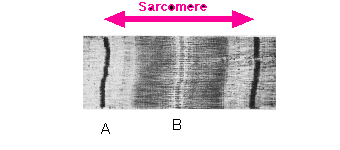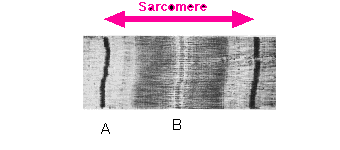Chapter 1 Quiz Cscs

Structure and Function of the Muscular, Neuromuscular, Cardiovascular, and Respiratory Systems
- 1.
What is the fibrous connective tissue that covers the outside of muscle?
- A.
Epimysium
- B.
Perimysium
- C.
Endomysium
- D.
Sarcolemma
Correct Answer
A. EpimysiumExplanation
Epimysium is the fibrous connective tissue that covers the outside of muscle. It is a dense layer of collagen fibers that surrounds the entire muscle, providing protection and support. It helps to maintain the shape of the muscle and allows for smooth movement by connecting the muscle to surrounding structures. The epimysium also contains blood vessels and nerves that supply the muscle with nutrients and signals for contraction.Rate this question:
-
- 2.
______ is the thick structural protein in the sarcomere.
- A.
Actin
- B.
Myosin
- C.
Z-line
- D.
Sarcolemma
Correct Answer
B. MyosinExplanation
Myosin is the thick structural protein in the sarcomere. It is responsible for muscle contraction by interacting with actin filaments. Myosin contains a head region that binds to actin and a tail region that allows it to form thick filaments. These thick filaments, along with the thin actin filaments, make up the sarcomere, which is the basic unit of muscle contraction. The Z-line is a protein structure that anchors the actin filaments, while the sarcolemma is the cell membrane of muscle fibers. Therefore, the correct answer is Myosin.Rate this question:
-
- 3.
The myosin head attaches to the actin allowing a ___________ to form.
Correct Answer
cross-bridgeExplanation
When the myosin head attaches to the actin, it forms a cross-bridge. This cross-bridge is a temporary connection between the myosin and actin filaments in muscle cells. It allows the myosin to exert a pulling force on the actin, resulting in muscle contraction. The formation and breaking of cross-bridges is a crucial step in the sliding filament theory of muscle contraction.Rate this question:
- 4.
Muscle fibers that have slow contraction and relaxation speeds and are small in diameter
- A.
Type I
- B.
Type IIa
- C.
Type IIb
- D.
Type II x
Correct Answer
A. Type IExplanation
Muscle fibers that have slow contraction and relaxation speeds and are small in diameter are classified as Type I fibers. These fibers are also known as slow-twitch fibers and are more resistant to fatigue. They are responsible for endurance activities such as long-distance running or cycling. Type I fibers have a high capacity for aerobic metabolism and contain a large number of mitochondria and myoglobin, which aids in oxygen storage. These fibers generate energy through oxidative phosphorylation and are characterized by a high concentration of slow-acting myosin ATPase.Rate this question:
-
- 5.
_________________ is the conscious appreciation of the position of body parts with respect to gravity.
Correct Answer
Kinesthetic SenseExplanation
The term "kinesthetic sense" refers to the conscious appreciation or awareness of the position of body parts in relation to gravity. This sense allows individuals to have a sense of body awareness and coordination, enabling them to perform tasks such as balancing, walking, and maintaining proper posture. It involves the sensory receptors located in muscles, tendons, and joints, which send signals to the brain about the body's position and movement. The kinesthetic sense plays a crucial role in motor control and is essential for everyday activities that require coordination and balance.Rate this question:
- 6.
What body system is responsible for transport of nutrients, removal of waste, and body regulation?
- A.
Respiratory
- B.
Cardiovascular
- C.
Muscular
- D.
Neurovascular
Correct Answer
B. CardiovascularExplanation
The cardiovascular system, which includes the heart, blood vessels, and blood, is responsible for the transport of nutrients, removal of waste, and body regulation. The heart pumps oxygenated blood to the body's tissues, delivering essential nutrients and removing waste products. The blood vessels facilitate the circulation of blood throughout the body, ensuring that all cells receive the necessary nutrients and oxygen. Additionally, the cardiovascular system helps regulate body temperature, pH balance, and hormone distribution.Rate this question:
-
- 7.
The ________ valve is between the right atrium and the right ventricle
Correct Answer
tricuspidExplanation
The tricuspid valve is located between the right atrium and the right ventricle of the heart. It consists of three cusps or leaflets that open and close to regulate blood flow. When the atrium contracts, the tricuspid valve opens, allowing blood to flow into the ventricle. When the ventricle contracts, the valve closes to prevent blood from flowing back into the atrium, ensuring a one-way flow of blood through the heart.Rate this question:
- 8.
In an Electrocardiogram the __________ is generated by changes in electrical potential of cardiac muscle cells that depolarize the atria and result in atrial contraction.
- A.
P-wave
- B.
QRS Complex
- C.
T-wave
Correct Answer
A. P-waveExplanation
The P-wave in an electrocardiogram represents the depolarization of the atria, which leads to atrial contraction. This electrical potential change is generated by the cardiac muscle cells and is recorded as a small upward deflection on the ECG. The P-wave is followed by the QRS complex, which represents the depolarization of the ventricles, and the T-wave, which represents the repolarization of the ventricles. Therefore, the correct answer is the P-wave.Rate this question:
-
- 9.
In an Electrocardiogram the __________ is generated by the electrical potential ventricles repolarize.
- A.
P wave
- B.
QRS Complex
- C.
T wave
Correct Answer
C. T waveExplanation
The T wave in an electrocardiogram is generated by the electrical potential ventricles repolarizing. Repolarization refers to the process in which the ventricles relax and reset their electrical charge after contraction. This repolarization phase is represented by the T wave on the ECG, indicating that the ventricles are preparing for the next heartbeat. The P wave represents atrial depolarization, while the QRS complex represents ventricular depolarization.Rate this question:
-
- 10.
_______ rapidly transport blood pumped FROM the heart, they have strong, muscular walls.
Correct Answer
ArteriesExplanation
Arteries are blood vessels that carry oxygenated blood away from the heart to various parts of the body. They have strong and muscular walls which enable them to withstand the high pressure and force exerted by the heart during pumping. This allows arteries to rapidly transport blood throughout the body, ensuring efficient delivery of oxygen and nutrients to the organs and tissues.Rate this question:
- 11.
_______ function to exchange oxygen, fluid, nutrients, electrolytes, hormones, and other substances between the blood and the interstitial fluid in the various tissues of the body.
- A.
Arteries
- B.
Arterioles
- C.
Capillaries
- D.
Veins
- E.
Venules
Correct Answer
C. CapillariesExplanation
Capillaries are the smallest blood vessels in the body and they play a crucial role in the exchange of oxygen, fluid, nutrients, electrolytes, hormones, and other substances between the blood and the interstitial fluid in the various tissues of the body. Their thin walls and large surface area allow for efficient diffusion of these substances. Arteries and veins are larger blood vessels that transport blood to and from the capillaries, while arterioles and venules are smaller vessels that connect arteries and veins to the capillaries. However, it is the capillaries that are directly responsible for the exchange of substances between the blood and the interstitial fluid.Rate this question:
-
- 12.
The transport of oxygen is accomplished by __________ in the red blood cells
Correct Answer
hemoglobinExplanation
Hemoglobin is a protein found in red blood cells that is responsible for carrying oxygen from the lungs to the tissues of the body. It binds to oxygen in the lungs, forming a complex called oxyhemoglobin, and then releases oxygen in the tissues where it is needed. This process allows for efficient transport of oxygen throughout the body, ensuring that all cells receive the oxygen they require for proper functioning.Rate this question:
- 13.
Gas exchange in the respiratory system occurs at the __________.
Correct Answer
alveoliExplanation
Gas exchange in the respiratory system occurs at the alveoli. The alveoli are tiny air sacs found at the end of the bronchioles in the lungs. They are surrounded by a network of capillaries, allowing for the exchange of oxygen and carbon dioxide between the air in the alveoli and the bloodstream. This exchange is essential for supplying oxygen to the body's cells and removing carbon dioxide, a waste product of cellular respiration.Rate this question:
- 14.
What is A
Correct Answer
Z line - 15.
What is B
Correct Answer
M line - 16.
The _________ is the intrinsic pacemaker, where rhythmic electrical impulses are normally initiated.
- A.
Sinoatrial Node
- B.
Atrioventricular Node
- C.
Atrioventricular Bundle
- D.
Purkinje Fibers
Correct Answer
A. Sinoatrial NodeExplanation
The sinoatrial node is the correct answer because it is the natural pacemaker of the heart. It is responsible for initiating the electrical signals that regulate the heart's rhythm. These signals are then transmitted to the atrioventricular node, atrioventricular bundle, and purkinje fibers, which help coordinate the contraction of the heart chambers.Rate this question:
-
- 17.
The 's function is to store and release Calcium ions to regulate muscle contractions.
- A.
Endoplasmic Reticulum
- B.
Myosomial Ribosome
- C.
Endomysium
- D.
Sarcoplasmic Reticulum
Correct Answer
D. Sarcoplasmic ReticulumExplanation
The sarcoplasmic reticulum is responsible for storing and releasing calcium ions, which are crucial for regulating muscle contractions. It is a specialized type of endoplasmic reticulum found in muscle cells. The other options listed, such as endomysium and myosomial ribosome, do not have the specific function of storing and releasing calcium ions for muscle contractions.Rate this question:
-
- 18.
Proprioceptors that respond to stretch and are located in tendons near the musculotendinous junction are know as .
Correct Answer
golgi tendon organs
Golgi tendon organs
GTO'sExplanation
Proprioceptors that respond to stretch and are located in tendons near the musculotendinous junction are known as Golgi tendon organs or GTO's. These specialized sensory receptors are responsible for detecting changes in muscle tension and transmitting this information to the central nervous system. They play a crucial role in protecting muscles and tendons from excessive force and injury by initiating a reflex relaxation of the muscle when tension becomes too high.Rate this question:
- 19.
is a convergence of smaller contractions in order to create a steady contraction.
- A.
Tetanus
- B.
Twitch
- C.
Slow Twitch
- D.
Negative potential
Correct Answer
A. TetanusExplanation
Tetanus refers to a condition where there is a continuous and sustained contraction of muscles. This is caused by the repeated stimulation of muscle fibers, leading to a buildup of tension and a lack of relaxation. The term "convergence of smaller contractions" suggests that multiple smaller contractions are coming together to create a steady and sustained contraction, which is characteristic of tetanus. Therefore, tetanus is the correct answer.Rate this question:
-
Quiz Review Timeline +
Our quizzes are rigorously reviewed, monitored and continuously updated by our expert board to maintain accuracy, relevance, and timeliness.
-
Current Version
-
Mar 21, 2023Quiz Edited by
ProProfs Editorial Team -
Jan 25, 2010Quiz Created by
Wrapped120
 Back to top
Back to top



